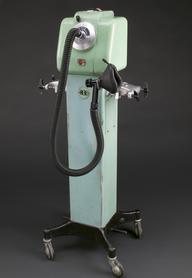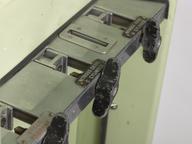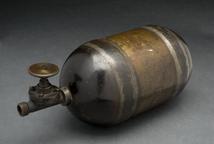


Portable "Walton Minnitt" apparatus for nitrous oxide and air analgesia, by Coxeter, 1936-1950
R J Minnit (1889-1974), with the help of Arthur Charles King (1888-1965), developed a modification of an existing anaesthetic apparatus to replace chloroform as a pain reliever for mothers during childbirth. Once the potentially toxic nature of chloroform had become apparent, it was used far more cautiously.
In this device, nitrous oxide fills the rubber bag underneath the glass, which as it expands lifts the metal plate to close off the supply of gas. As the patient inhales through the mask, the nitrous oxide is mixed with air. The portable box was designed so mothers could self-administer the gas and air. Gas and air are still used today. This model is known as the ‘Walton-Minnit’ and was first sold in 1936.
Details
- Category:
- Anaesthesiology
- Object Number:
- 1981-986
- Materials:
- case, wood, case, glass, apparatus, metal and apparatus, rubber
- Measurements:
-
overall: 200 mm
- type:
- anaesthetic machine
- credit:
- Hypher, T.J.




